A Detailed Analysis of Giotto di Bondone's The Lamentation Artwork
VerifiedAdded on 2023/03/20
|5
|1464
|88
Report
AI Summary
This report provides a comprehensive analysis of Giotto di Bondone's 'The Lamentation,' examining its historical context within the Renaissance art movement and its significance in Western art. The report delves into the artwork's visual elements, including the use of line, color, and space to convey emotion and narrative. It also explores the design principles employed by Giotto, such as balance, proportion, and emphasis, and how these contribute to the overall impact and meaning of the painting. The analysis includes a discussion of how Giotto's techniques and style, particularly his use of fresco painting, influenced subsequent artists. Furthermore, the report highlights the emotional impact of the artwork, emphasizing its portrayal of human grief and mourning, and concludes with a reflection on the lasting legacy of Giotto's work in the field of art history. The report references scholarly sources to support its claims and provides a detailed understanding of Giotto's artistic innovations.
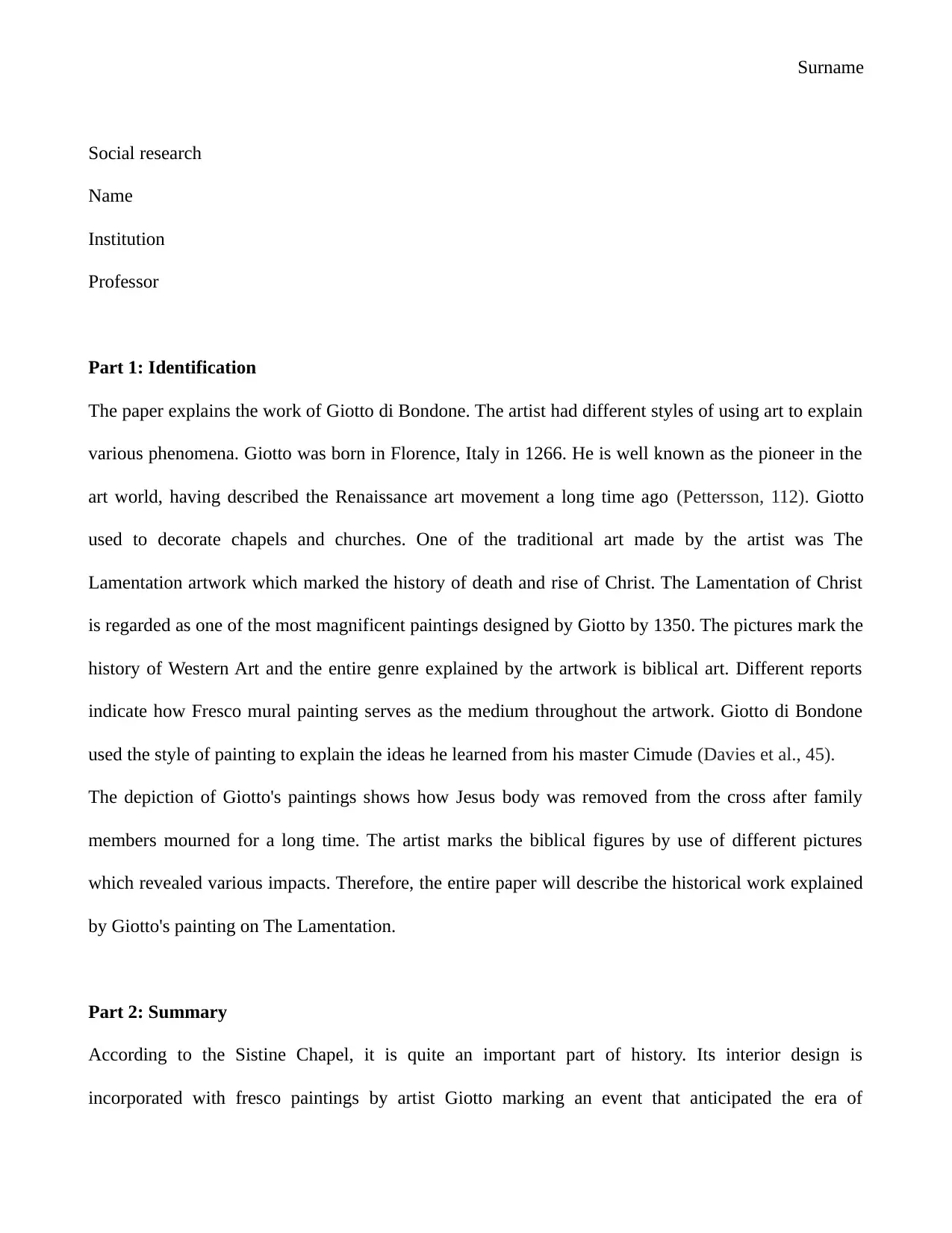
Surname
Social research
Name
Institution
Professor
Part 1: Identification
The paper explains the work of Giotto di Bondone. The artist had different styles of using art to explain
various phenomena. Giotto was born in Florence, Italy in 1266. He is well known as the pioneer in the
art world, having described the Renaissance art movement a long time ago (Pettersson, 112). Giotto
used to decorate chapels and churches. One of the traditional art made by the artist was The
Lamentation artwork which marked the history of death and rise of Christ. The Lamentation of Christ
is regarded as one of the most magnificent paintings designed by Giotto by 1350. The pictures mark the
history of Western Art and the entire genre explained by the artwork is biblical art. Different reports
indicate how Fresco mural painting serves as the medium throughout the artwork. Giotto di Bondone
used the style of painting to explain the ideas he learned from his master Cimude (Davies et al., 45).
The depiction of Giotto's paintings shows how Jesus body was removed from the cross after family
members mourned for a long time. The artist marks the biblical figures by use of different pictures
which revealed various impacts. Therefore, the entire paper will describe the historical work explained
by Giotto's painting on The Lamentation.
Part 2: Summary
According to the Sistine Chapel, it is quite an important part of history. Its interior design is
incorporated with fresco paintings by artist Giotto marking an event that anticipated the era of
Social research
Name
Institution
Professor
Part 1: Identification
The paper explains the work of Giotto di Bondone. The artist had different styles of using art to explain
various phenomena. Giotto was born in Florence, Italy in 1266. He is well known as the pioneer in the
art world, having described the Renaissance art movement a long time ago (Pettersson, 112). Giotto
used to decorate chapels and churches. One of the traditional art made by the artist was The
Lamentation artwork which marked the history of death and rise of Christ. The Lamentation of Christ
is regarded as one of the most magnificent paintings designed by Giotto by 1350. The pictures mark the
history of Western Art and the entire genre explained by the artwork is biblical art. Different reports
indicate how Fresco mural painting serves as the medium throughout the artwork. Giotto di Bondone
used the style of painting to explain the ideas he learned from his master Cimude (Davies et al., 45).
The depiction of Giotto's paintings shows how Jesus body was removed from the cross after family
members mourned for a long time. The artist marks the biblical figures by use of different pictures
which revealed various impacts. Therefore, the entire paper will describe the historical work explained
by Giotto's painting on The Lamentation.
Part 2: Summary
According to the Sistine Chapel, it is quite an important part of history. Its interior design is
incorporated with fresco paintings by artist Giotto marking an event that anticipated the era of
Paraphrase This Document
Need a fresh take? Get an instant paraphrase of this document with our AI Paraphraser
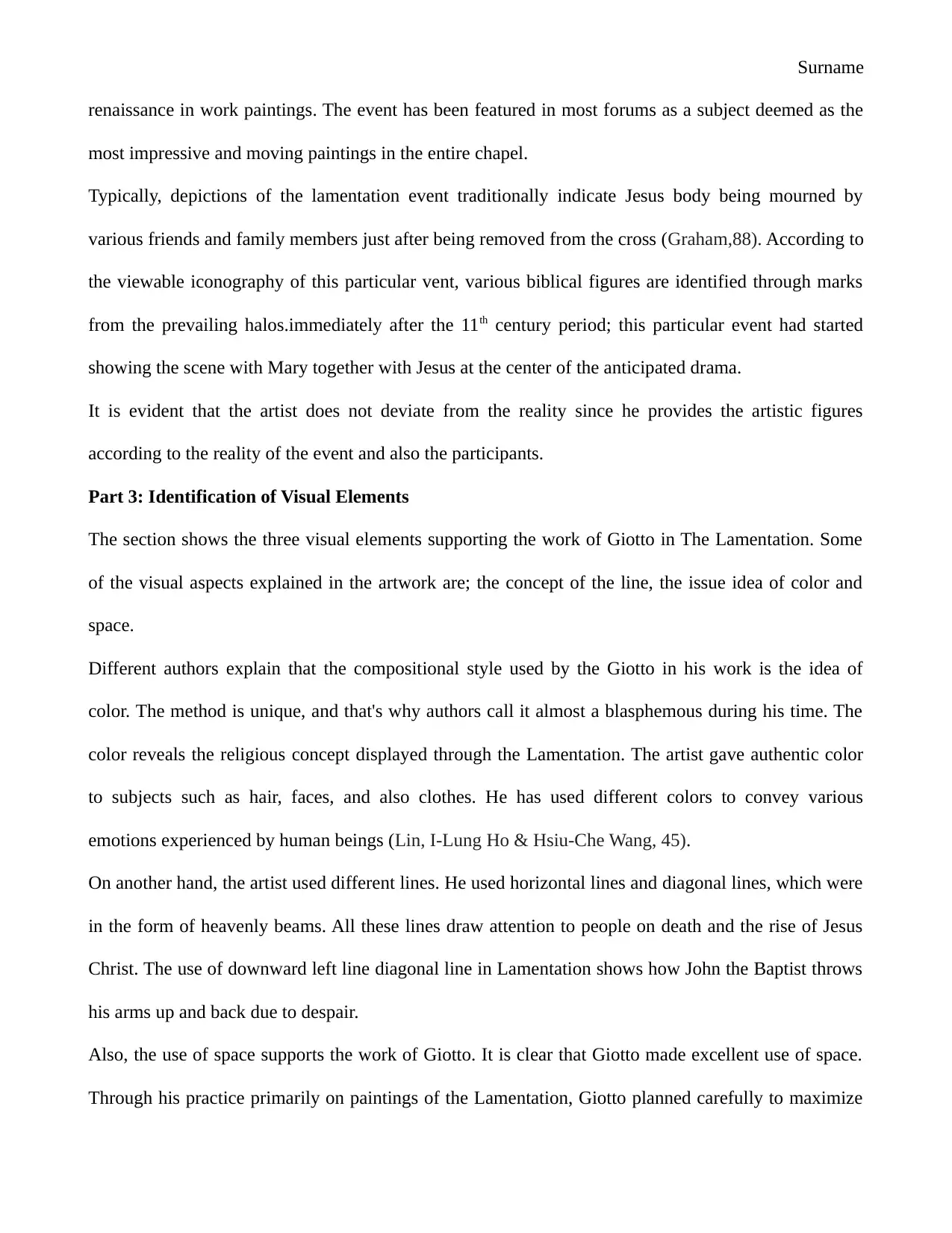
Surname
renaissance in work paintings. The event has been featured in most forums as a subject deemed as the
most impressive and moving paintings in the entire chapel.
Typically, depictions of the lamentation event traditionally indicate Jesus body being mourned by
various friends and family members just after being removed from the cross (Graham,88). According to
the viewable iconography of this particular vent, various biblical figures are identified through marks
from the prevailing halos.immediately after the 11th century period; this particular event had started
showing the scene with Mary together with Jesus at the center of the anticipated drama.
It is evident that the artist does not deviate from the reality since he provides the artistic figures
according to the reality of the event and also the participants.
Part 3: Identification of Visual Elements
The section shows the three visual elements supporting the work of Giotto in The Lamentation. Some
of the visual aspects explained in the artwork are; the concept of the line, the issue idea of color and
space.
Different authors explain that the compositional style used by the Giotto in his work is the idea of
color. The method is unique, and that's why authors call it almost a blasphemous during his time. The
color reveals the religious concept displayed through the Lamentation. The artist gave authentic color
to subjects such as hair, faces, and also clothes. He has used different colors to convey various
emotions experienced by human beings (Lin, I-Lung Ho & Hsiu-Che Wang, 45).
On another hand, the artist used different lines. He used horizontal lines and diagonal lines, which were
in the form of heavenly beams. All these lines draw attention to people on death and the rise of Jesus
Christ. The use of downward left line diagonal line in Lamentation shows how John the Baptist throws
his arms up and back due to despair.
Also, the use of space supports the work of Giotto. It is clear that Giotto made excellent use of space.
Through his practice primarily on paintings of the Lamentation, Giotto planned carefully to maximize
renaissance in work paintings. The event has been featured in most forums as a subject deemed as the
most impressive and moving paintings in the entire chapel.
Typically, depictions of the lamentation event traditionally indicate Jesus body being mourned by
various friends and family members just after being removed from the cross (Graham,88). According to
the viewable iconography of this particular vent, various biblical figures are identified through marks
from the prevailing halos.immediately after the 11th century period; this particular event had started
showing the scene with Mary together with Jesus at the center of the anticipated drama.
It is evident that the artist does not deviate from the reality since he provides the artistic figures
according to the reality of the event and also the participants.
Part 3: Identification of Visual Elements
The section shows the three visual elements supporting the work of Giotto in The Lamentation. Some
of the visual aspects explained in the artwork are; the concept of the line, the issue idea of color and
space.
Different authors explain that the compositional style used by the Giotto in his work is the idea of
color. The method is unique, and that's why authors call it almost a blasphemous during his time. The
color reveals the religious concept displayed through the Lamentation. The artist gave authentic color
to subjects such as hair, faces, and also clothes. He has used different colors to convey various
emotions experienced by human beings (Lin, I-Lung Ho & Hsiu-Che Wang, 45).
On another hand, the artist used different lines. He used horizontal lines and diagonal lines, which were
in the form of heavenly beams. All these lines draw attention to people on death and the rise of Jesus
Christ. The use of downward left line diagonal line in Lamentation shows how John the Baptist throws
his arms up and back due to despair.
Also, the use of space supports the work of Giotto. It is clear that Giotto made excellent use of space.
Through his practice primarily on paintings of the Lamentation, Giotto planned carefully to maximize
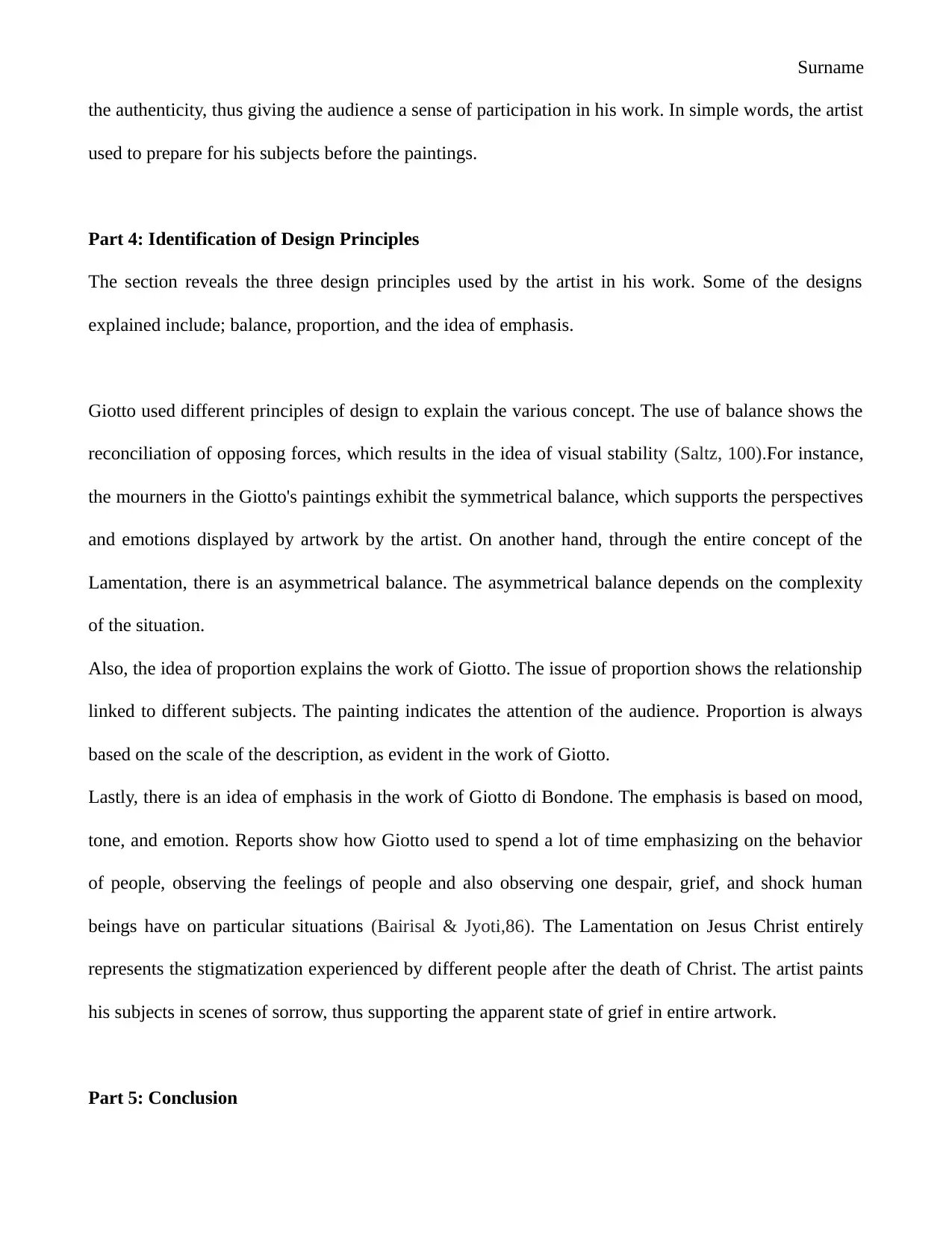
Surname
the authenticity, thus giving the audience a sense of participation in his work. In simple words, the artist
used to prepare for his subjects before the paintings.
Part 4: Identification of Design Principles
The section reveals the three design principles used by the artist in his work. Some of the designs
explained include; balance, proportion, and the idea of emphasis.
Giotto used different principles of design to explain the various concept. The use of balance shows the
reconciliation of opposing forces, which results in the idea of visual stability (Saltz, 100).For instance,
the mourners in the Giotto's paintings exhibit the symmetrical balance, which supports the perspectives
and emotions displayed by artwork by the artist. On another hand, through the entire concept of the
Lamentation, there is an asymmetrical balance. The asymmetrical balance depends on the complexity
of the situation.
Also, the idea of proportion explains the work of Giotto. The issue of proportion shows the relationship
linked to different subjects. The painting indicates the attention of the audience. Proportion is always
based on the scale of the description, as evident in the work of Giotto.
Lastly, there is an idea of emphasis in the work of Giotto di Bondone. The emphasis is based on mood,
tone, and emotion. Reports show how Giotto used to spend a lot of time emphasizing on the behavior
of people, observing the feelings of people and also observing one despair, grief, and shock human
beings have on particular situations (Bairisal & Jyoti,86). The Lamentation on Jesus Christ entirely
represents the stigmatization experienced by different people after the death of Christ. The artist paints
his subjects in scenes of sorrow, thus supporting the apparent state of grief in entire artwork.
Part 5: Conclusion
the authenticity, thus giving the audience a sense of participation in his work. In simple words, the artist
used to prepare for his subjects before the paintings.
Part 4: Identification of Design Principles
The section reveals the three design principles used by the artist in his work. Some of the designs
explained include; balance, proportion, and the idea of emphasis.
Giotto used different principles of design to explain the various concept. The use of balance shows the
reconciliation of opposing forces, which results in the idea of visual stability (Saltz, 100).For instance,
the mourners in the Giotto's paintings exhibit the symmetrical balance, which supports the perspectives
and emotions displayed by artwork by the artist. On another hand, through the entire concept of the
Lamentation, there is an asymmetrical balance. The asymmetrical balance depends on the complexity
of the situation.
Also, the idea of proportion explains the work of Giotto. The issue of proportion shows the relationship
linked to different subjects. The painting indicates the attention of the audience. Proportion is always
based on the scale of the description, as evident in the work of Giotto.
Lastly, there is an idea of emphasis in the work of Giotto di Bondone. The emphasis is based on mood,
tone, and emotion. Reports show how Giotto used to spend a lot of time emphasizing on the behavior
of people, observing the feelings of people and also observing one despair, grief, and shock human
beings have on particular situations (Bairisal & Jyoti,86). The Lamentation on Jesus Christ entirely
represents the stigmatization experienced by different people after the death of Christ. The artist paints
his subjects in scenes of sorrow, thus supporting the apparent state of grief in entire artwork.
Part 5: Conclusion
⊘ This is a preview!⊘
Do you want full access?
Subscribe today to unlock all pages.

Trusted by 1+ million students worldwide
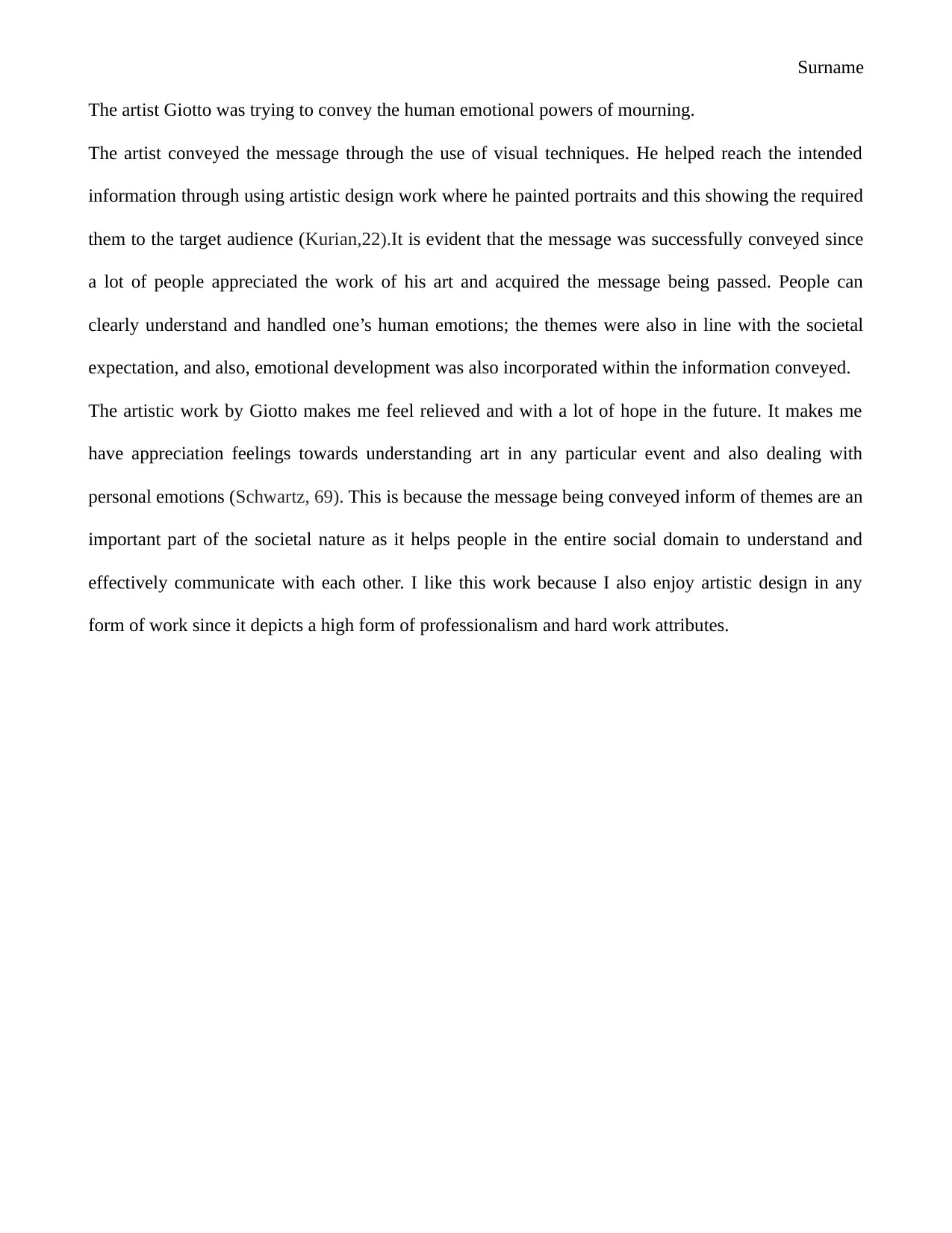
Surname
The artist Giotto was trying to convey the human emotional powers of mourning.
The artist conveyed the message through the use of visual techniques. He helped reach the intended
information through using artistic design work where he painted portraits and this showing the required
them to the target audience (Kurian,22).It is evident that the message was successfully conveyed since
a lot of people appreciated the work of his art and acquired the message being passed. People can
clearly understand and handled one’s human emotions; the themes were also in line with the societal
expectation, and also, emotional development was also incorporated within the information conveyed.
The artistic work by Giotto makes me feel relieved and with a lot of hope in the future. It makes me
have appreciation feelings towards understanding art in any particular event and also dealing with
personal emotions (Schwartz, 69). This is because the message being conveyed inform of themes are an
important part of the societal nature as it helps people in the entire social domain to understand and
effectively communicate with each other. I like this work because I also enjoy artistic design in any
form of work since it depicts a high form of professionalism and hard work attributes.
The artist Giotto was trying to convey the human emotional powers of mourning.
The artist conveyed the message through the use of visual techniques. He helped reach the intended
information through using artistic design work where he painted portraits and this showing the required
them to the target audience (Kurian,22).It is evident that the message was successfully conveyed since
a lot of people appreciated the work of his art and acquired the message being passed. People can
clearly understand and handled one’s human emotions; the themes were also in line with the societal
expectation, and also, emotional development was also incorporated within the information conveyed.
The artistic work by Giotto makes me feel relieved and with a lot of hope in the future. It makes me
have appreciation feelings towards understanding art in any particular event and also dealing with
personal emotions (Schwartz, 69). This is because the message being conveyed inform of themes are an
important part of the societal nature as it helps people in the entire social domain to understand and
effectively communicate with each other. I like this work because I also enjoy artistic design in any
form of work since it depicts a high form of professionalism and hard work attributes.
Paraphrase This Document
Need a fresh take? Get an instant paraphrase of this document with our AI Paraphraser
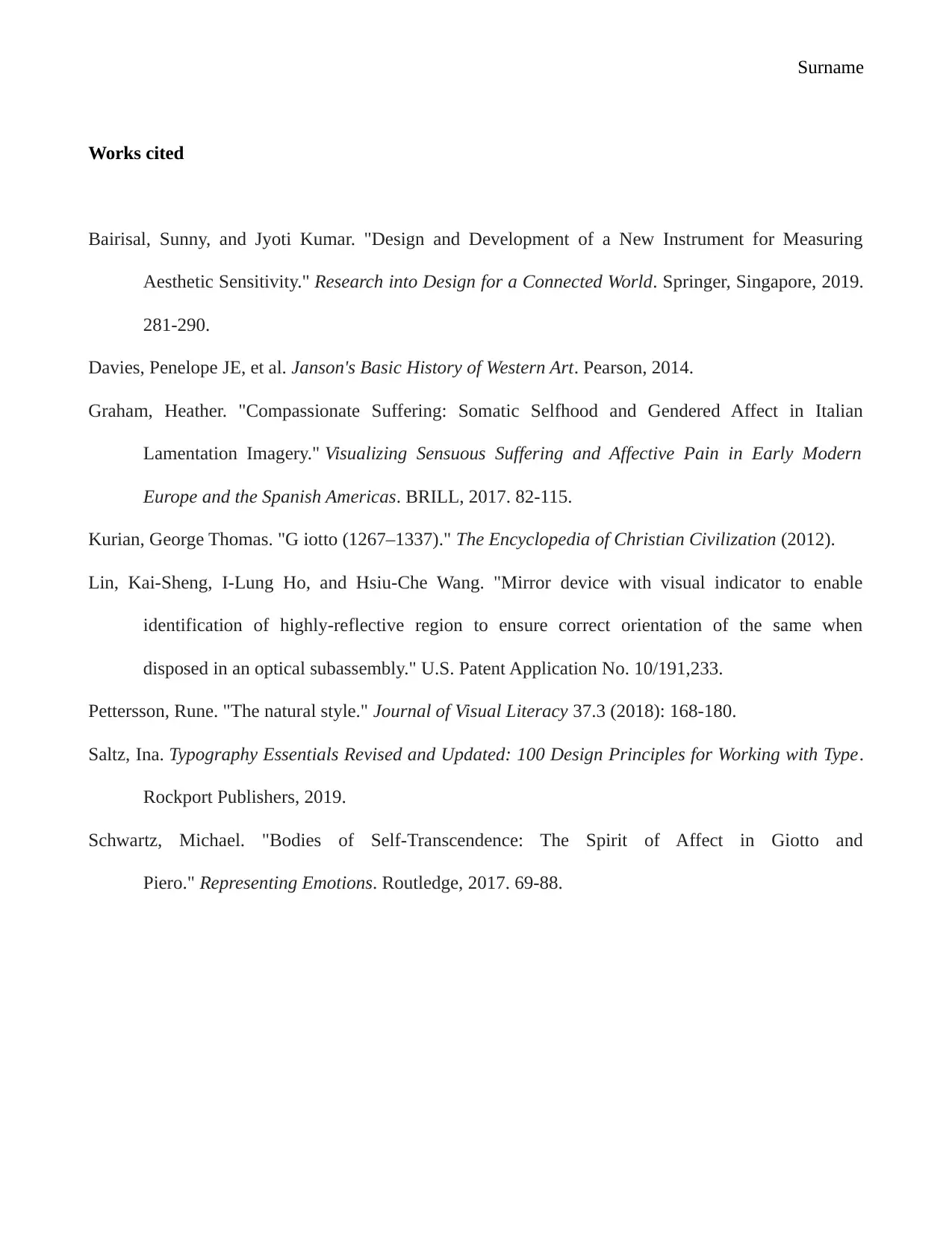
Surname
Works cited
Bairisal, Sunny, and Jyoti Kumar. "Design and Development of a New Instrument for Measuring
Aesthetic Sensitivity." Research into Design for a Connected World. Springer, Singapore, 2019.
281-290.
Davies, Penelope JE, et al. Janson's Basic History of Western Art. Pearson, 2014.
Graham, Heather. "Compassionate Suffering: Somatic Selfhood and Gendered Affect in Italian
Lamentation Imagery." Visualizing Sensuous Suffering and Affective Pain in Early Modern
Europe and the Spanish Americas. BRILL, 2017. 82-115.
Kurian, George Thomas. "G iotto (1267–1337)." The Encyclopedia of Christian Civilization (2012).
Lin, Kai-Sheng, I-Lung Ho, and Hsiu-Che Wang. "Mirror device with visual indicator to enable
identification of highly-reflective region to ensure correct orientation of the same when
disposed in an optical subassembly." U.S. Patent Application No. 10/191,233.
Pettersson, Rune. "The natural style." Journal of Visual Literacy 37.3 (2018): 168-180.
Saltz, Ina. Typography Essentials Revised and Updated: 100 Design Principles for Working with Type.
Rockport Publishers, 2019.
Schwartz, Michael. "Bodies of Self-Transcendence: The Spirit of Affect in Giotto and
Piero." Representing Emotions. Routledge, 2017. 69-88.
Works cited
Bairisal, Sunny, and Jyoti Kumar. "Design and Development of a New Instrument for Measuring
Aesthetic Sensitivity." Research into Design for a Connected World. Springer, Singapore, 2019.
281-290.
Davies, Penelope JE, et al. Janson's Basic History of Western Art. Pearson, 2014.
Graham, Heather. "Compassionate Suffering: Somatic Selfhood and Gendered Affect in Italian
Lamentation Imagery." Visualizing Sensuous Suffering and Affective Pain in Early Modern
Europe and the Spanish Americas. BRILL, 2017. 82-115.
Kurian, George Thomas. "G iotto (1267–1337)." The Encyclopedia of Christian Civilization (2012).
Lin, Kai-Sheng, I-Lung Ho, and Hsiu-Che Wang. "Mirror device with visual indicator to enable
identification of highly-reflective region to ensure correct orientation of the same when
disposed in an optical subassembly." U.S. Patent Application No. 10/191,233.
Pettersson, Rune. "The natural style." Journal of Visual Literacy 37.3 (2018): 168-180.
Saltz, Ina. Typography Essentials Revised and Updated: 100 Design Principles for Working with Type.
Rockport Publishers, 2019.
Schwartz, Michael. "Bodies of Self-Transcendence: The Spirit of Affect in Giotto and
Piero." Representing Emotions. Routledge, 2017. 69-88.
1 out of 5
Related Documents
Your All-in-One AI-Powered Toolkit for Academic Success.
+13062052269
info@desklib.com
Available 24*7 on WhatsApp / Email
![[object Object]](/_next/static/media/star-bottom.7253800d.svg)
Unlock your academic potential
Copyright © 2020–2025 A2Z Services. All Rights Reserved. Developed and managed by ZUCOL.





